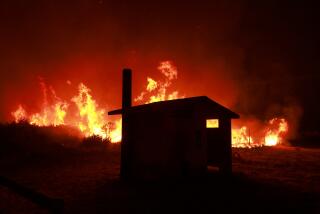O.C. to Be Burned Again by El Nino
- Share via
Lush and verdant, rain-soaked plants, trees and bushes are blanketing the county with unprecedented richness.
The emerald coverlet on trails, slopes and hillsides is an unusual treat for an area that last year at this time was sere and brown, but the greenery is only the first step to a fire season that could be as remarkable as the rainy one.
Traditionally, fire season statewide and in Orange County begins in early May. Yet fire officials in Los Angeles and Orange counties predict the 1998 fire season will begin about mid-June, one of the latest starts since record-keeping began in 1947, said Capt. Scott Brown, an Orange County Fire Authority spokesman.
The county’s fire season has opened June 15 three times--in 1995, 1982 and 1981, he said. By contrast, fire season began 12 times in early April--most recently in 1988, he said.
In Los Angeles County, fire season traditionally begins about May 15--a month earlier than this year’s likely start of June 17. Last year, though, the season began April 23, Fire Inspector Ed Loney said.
The delay this year has both good and bad ramifications.
The late-season rains mean fewer early fires. But when the brush does dry out, there will be an unprecedented amount of fuel to burn.
“I can verify that there’s going to be a lot more fuel this coming year than we’ve seen in recent years, and we attribute that to the amount of rain,” said Michael Phillips, fire prevention officer for Laguna Beach, where a wind-swept brush fire destroyed 440 homes and scorched 14,000 acres in 1993.
The city completed its weed and brush inspections and mailed notices to homeowners and landlords warning them to clear their properties by May 25. The city will clear the grounds of those who are tardy and bill them for the service, Phillips said.
Weed abatement contractors are busy every day, cutting back the brush and weeds on 25,000 undeveloped lots throughout the county, only to see them grow back with renewed health. Frustrated authorities have even called in herds of goats to chomp away at the vegetation.
“For everything we’ve cut so far, starting right around the first of April, there’s now a third to two-thirds more,” said Ed Stewart, whose company does fire prevention weeding for Laguna Beach, San Clemente, San Juan Capistrano and Dana Point.
“What scares me is it’s going to keep on like this: We’re going to get new growth off of the old stuff; then it’s going to turn hot real fast and then it’s going to burn,” Stewart said.
So far this season, average rainfall is more than twice that of last year. In the central Orange County area, 31.46 inches of rain fell this season, while the normal rainfall measures 12.41 inches. Last year, 14.91 inches of rain fell before summer began.
“It’s been a very wet season, but it is definitely winding down,” said John Sherwin, a meteorologist for WeatherData. “Climatology tells you that it’s got to stop raining soon--then the dry season will begin and unfortunately, everything begins to burn.”
Grasses and smaller plants will start drying or “curing” in the next few weeks and create the county’s first fire hazards.
“Grass is the predominant fuel bed and will be the major problem this year,” Brown said.
Larger plants, currently water-logged, will retain their moisture for weeks. But once they dry, they could act like torches during a wildfire.
“I think the most dangerous is the mustard plant,” Stewart said. “It grows 15 feet high and it dries out, and if it catches, the fire will roar up a hillside.”
More to Read
Sign up for Essential California
The most important California stories and recommendations in your inbox every morning.
You may occasionally receive promotional content from the Los Angeles Times.













